Much like the thoroughbreds they raise, train, sell and race, familial bloodlines often play a key role in the people who make a living in the industry. This exclusive Ocala Style series takes an up close and personal look into the multi-generational families involved in the Ocala-based Florida thoroughbred industry.
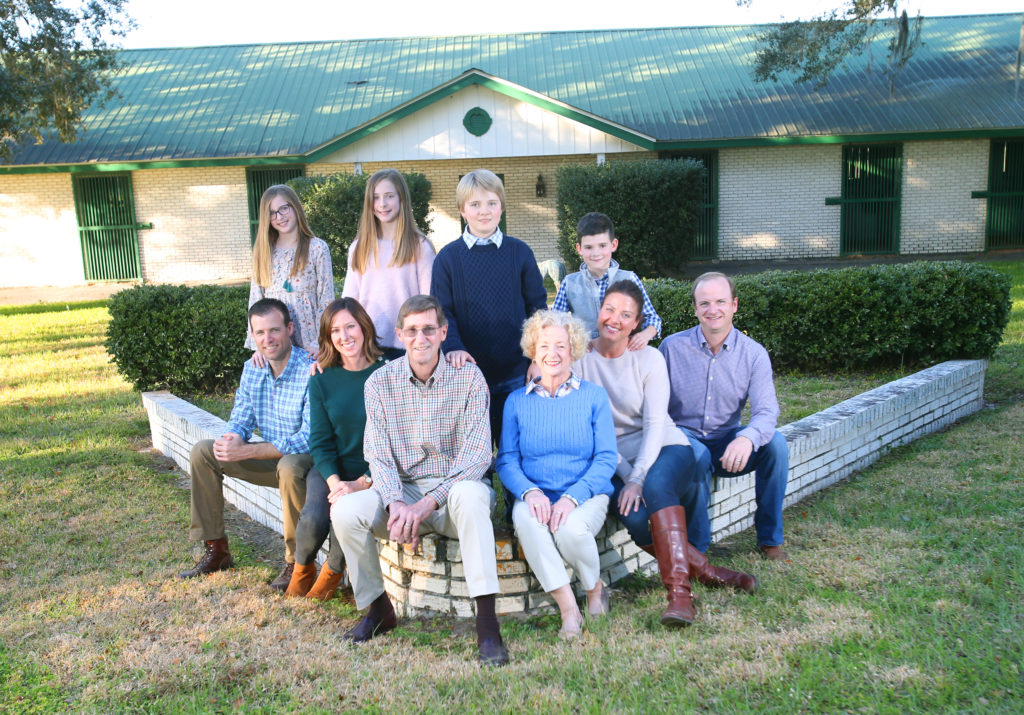
Members of the O’Farrell family, from left, top row, Annie, Maggie, Michael and John; bottom row, David, Allison, Mike, Judy, Alicia and Joe.
Mike O’Farrell Jr. was 8 when his father Joe O’Farrell moved the family from Maryland to Ocala. The elder O’Farrell was the co-owner and general manager of the newly established Ocala Stud, a thoroughbred operation located on Shady Road. It was 1956 and there were only four thoroughbred farms in the area, dirt roads leading to them. Two years later, there were 28 farms; a path through the woods connected Ocala Stud to new neighbor Bonnie Heath Farm.
“My sisters and I used to ride our ponies through that path in the woods to go play with the Heath kids,” recalls Mike. “Once we got through the woods, we could ride through the open countryside. And we could ride on the dirt roads to the other farms. Of course, over the decades all that changed.”
Dirt roads became asphalt highways and Interstate 75 long ago destroyed that path through the woods. The Paddock Mall, College of Central Florida, car dealerships, restaurants, hotels, apartments, housing developments, shopping centers and a high school have overtaken the area that was once the epicenter of the Florida thoroughbred industry.
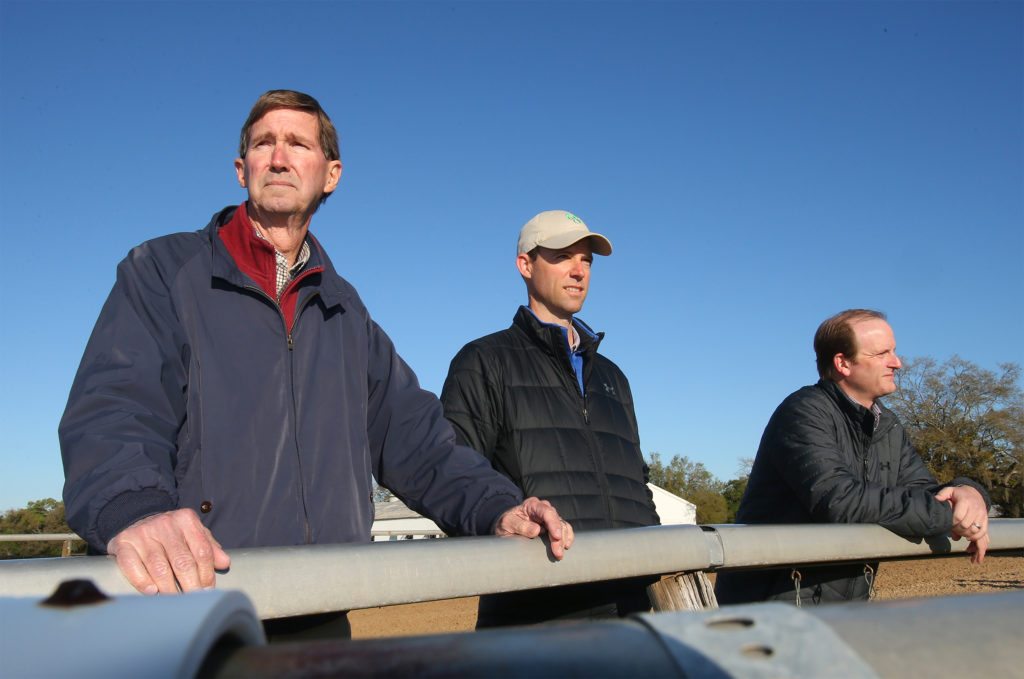
And yet, Ocala Stud, under O’Farrell family management, has endured to become the oldest active thoroughbred operation in Florida.
For more than six decades, Ocala Stud’s forest green and white barns have stood as sentinels to one of the area’s most scenic roads. Still called Shady Road by locals, the road is also now known as Southwest 27th Avenue/County Road 475A.
According to Mike O’Farrell, a ship’s bell on the property bears witness to its interesting history.
“Ocala Stud was founded in March of 1956. In May that year, Needles won the Kentucky Derby and nearly the Triple Crown. In 1957, My Dear Girl was born. She was from Ocala Stud’s first crop. She became Champion 2-year-old filly in 1959,” he explains. “With that to go along with Needles’ tremendous success, my father, being the promoter he was, started a friendly rivalry with some of his friends that were Kentucky breeders.” Louis Wolfson, breeder and owner of Triple Crown winner Affirmed, who built Harbor View Farm in Ocala, bought a horse from Ocala Stud named Roman Brother. He became Florida’s first Horse of the Year. The rivalry with Kentucky continued.
“One of Mr. Wolfson’s primary businesses was scrap metal. He was dismantling government equipment from WWII and was working on a battleship with a huge bell with USS Kentucky inscribed on it. He called my father and asked if he wanted it. Of course my father said yes,” Mike continues. “He placed the bell in front of our office and for years, anytime a Florida bred won a major race, he rang the bell. You could hear it from miles away.”
And, over the years, the metal Ocala Stud sign, just off the road, also has become an iconic marker. It is a favorite photo op location, particularly for men, both tourists and locals.
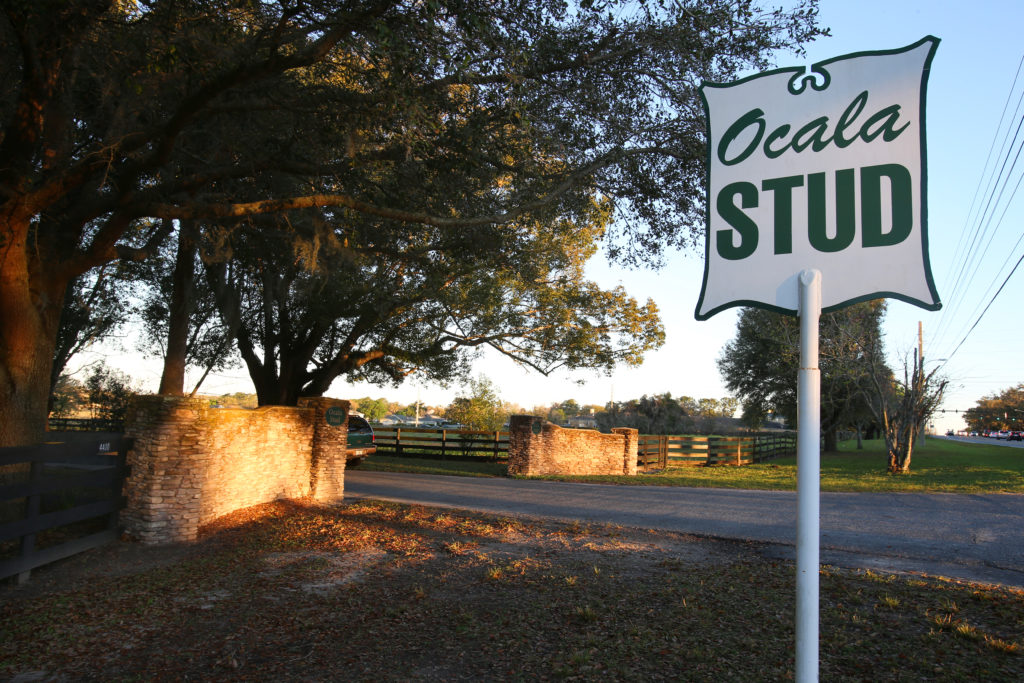
“When we built a new stone entrance to our farm driveway about 10 years ago, we took down the old metal sign,” says Mike, 72, who has now served as president and general manager of Ocala Stud for more than four decades. “I got plenty of calls about that sign being gone. I had to tell people not to worry, that the sign would be back after it was repainted. That’s when I realized how much the Ocala Stud sign had become part of the area. It’s nice to know that it means something to the community.”
Historical Serendipity
On January 16th, 1956, Maryland horseman Joe O’Farrell was part of a nine-person syndicate that paid $700,000 for 800 acres of what had been Ocala-based Dickey Stables. That May, Needles, bred by William Leach who had owned Dickey Stables, became the first Florida-bred to win the Kentucky Derby. When Needles was also named the 1956 North American champion 3-year-old male, the spotlight shone brightly on Ocala as a viable thoroughbred industry center.
O’Farrell quickly built up a broodmare band, a training operation and brought stallion Rough’n Tumble from Maryland to stand at Ocala Stud. Rough’n Tumble became the first foundation stallion of the Florida thoroughbred industry. On February 25th, 1957, O’Farrell staged the first-ever 2-year-olds in training sale at Miami-based Hialeah Park racetrack. 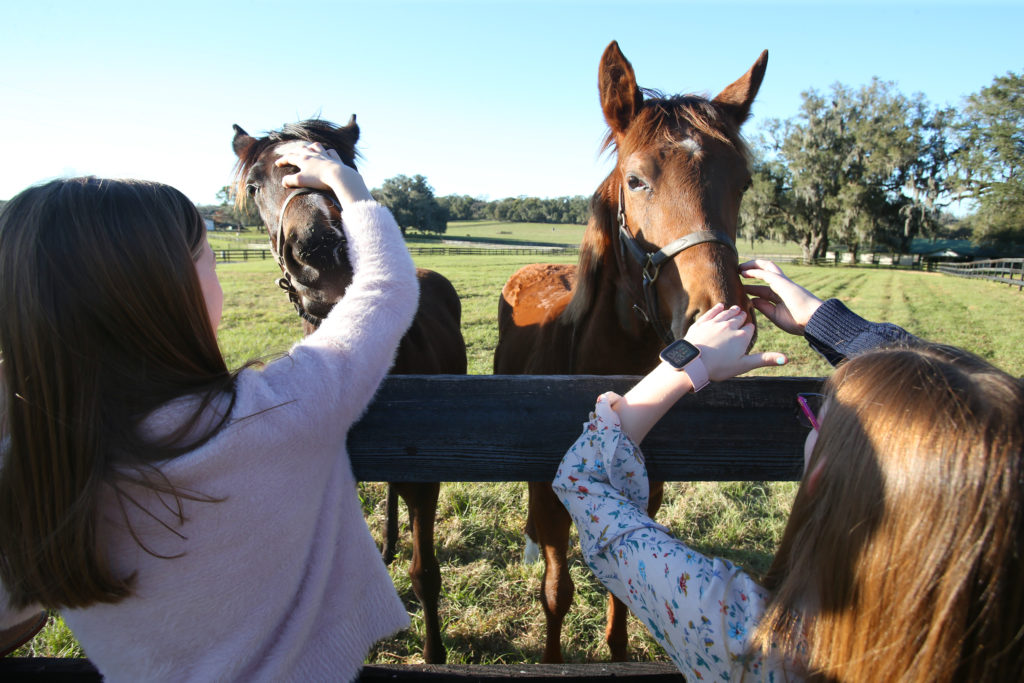 He followed that with becoming one of the founding members of the Florida Breeders’ Sales Company (1958) and later the Ocala Breeders’ Sales Company (1974).
He followed that with becoming one of the founding members of the Florida Breeders’ Sales Company (1958) and later the Ocala Breeders’ Sales Company (1974).
Success as a breeder came quickly for Ocala Stud. After the success of My Dear Girl, by 1960, Ocala Stud had bred and/or sold winners of more than $1 million in earnings, finishing 10th that year on the list of leading breeders in North America.
In 1982, the Florida Department of Agriculture and Consumer Services honored Joe O’Farrell with the External Distinguished Service Award. In 1991, he was inducted posthumously into the Florida Agricultural Hall of Fame.
Taking the Lead
Following his father’s heart attack and the farm’s financial reorganization in 1971, Mike took over the day-to-day operations of Ocala Stud. He was 22, leaving the University of Florida a semester away from an agricultural business degree.
“I had to step in a little sooner than anticipated. But I never had any intentions or desire to do anything else but be in the thoroughbred business,” says Mike, whose father died in 1982. “I was grateful that my father and I got to work together to rebuild Ocala Stud. And with the help of a lot of good people, perseverance and luck, we’ve managed to still be here today.”
According to O’Farrell, the toughest time was 1971 and its aftermath.
“Following my father’s heart attack, the farm’s syndicate partnership disolved and the farm was foreclosed on by the bank. All the horses were sold,” recalls Mike, a lanky 6-foot-5 with a Jimmy Stewart demeanor. “We weren’t sure how we were going to move forward.”
But Ocala Stud, albeit a scaled-down version, did move forward.
“Roy Kennedy, who was a banker and a horseman, helped us buy back the main 185 acres of the farm,” says Mike. “Herbert Allen, who had been one of our longtime clients, sold us a package of 10 broodmares, seven yearlings and sent a stallion to stand at the farm. He let us pay him back over time. The whole experience taught me that things don’t stay good forever and things don’t stay bad forever. I’ve never forgotten that lesson.”

Ocala Stud expanded its operation in 1980 with the addition of the 240-acre Ocala Stud Annex. Twelve miles northeast of the main farm, it’s the weanling/yearling division. It’s also where Mike and his wife Judy relocated to and raised their sons, Joe and David. The Ocala Stud holdings grew again in 1981 with the acquisition of the 120-acre Shady Lane broodmare division, a half-mile south of the main farm.
Today, Mike O’Farrell shares Ocala Stud ownership with sisters Susan Greiner and Anna O’Farrell, brother-in-law James Lewis and nieces Claire and Meghan Lewis, the husband and daughters of O’Farrell’s late sister Margaret.
“We still operate on the business model my father established,” says Mike. “We are a commercial breeding and training operation; we stand stallions; and we sell our annual crop of 2-year-olds in training at OBS.”
And Ocala Stud continues to be successful. The Florida Thoroughbred Breeders’ and Owners’ Association (FTBOA) named Ocala Stud the Florida Breeder of the Year in 2010, 2011, 2012, 2014 and 2018.
Generation Next
It wasn’t etched in stone that Mike and Judy’s sons would automatically become involved in Ocala Stud. Even if their names were Joseph Michael O’Farrell III and John David O’Farrell.
 “Judy and I didn’t want to force Joe and David to become involved in the thoroughbred business. We decided it was best to allow our sons to know there were other opportunities out there,” says Mike. “Growing up, Joe and David spent more time playing sports than being around the horses. They were allowed to pursue whatever other interests they wanted to.”
“Judy and I didn’t want to force Joe and David to become involved in the thoroughbred business. We decided it was best to allow our sons to know there were other opportunities out there,” says Mike. “Growing up, Joe and David spent more time playing sports than being around the horses. They were allowed to pursue whatever other interests they wanted to.”
The no-pressure approach allowed the O’Farrell boys to eventually find their own way to the farm. Today, Joe, 42, is the operation’s financial manager and David, 39, serves as the farm manager.
“When Dad went to the farm, he was going to work like any other father,” offers Joe. “And when Dad left the farm at the end of the day, he left the thoroughbred business at the farm. With our father, family time was family time. The conversation at the dinner table was not about the farm business.”
To which David adds, “My brother and I were both into sports from a very early age, so our parents stayed busy taking us to practices and games. Sure, we had horses around us and we went to the farm, but Dad never pushed us to become involved in the farm business.”
Joe and David attended Erskine College in Due West, South Carolina, each earning business degrees. After graduating in 1999, Joe became an accountant with a bank in South Carolina. David graduated in May 2003 and by that July was working at Ocala Stud.
“While I was in college, I started to keep track of Ocala Stud-bred horses at the races,” says David, a 6-foot-3 extrovert. “And I found myself becoming more and more interested in thoroughbred racing. I told my Dad that as soon as I graduated, I wanted to come back and work on the farm.”
For Joe, it was a 2003 O’Farrell family vacation at Saratoga Race Course in Saratoga Springs, New York, that would lead him to join his father and brother in running Ocala Stud.
“During that summer vacation at Saratoga, there was a horse that Ocala Stud bred and sold, named Chapel Royal, who was running then. He won a major race and I got really excited about it,” recalls Joe, who carefully considers every word before speaking. “I started thinking that working for the farm might be more fulfilling than working at a bank. So, I quit my bank job and went to work at the farm in 2004.”
But there would be no nepotism for David and Joe.
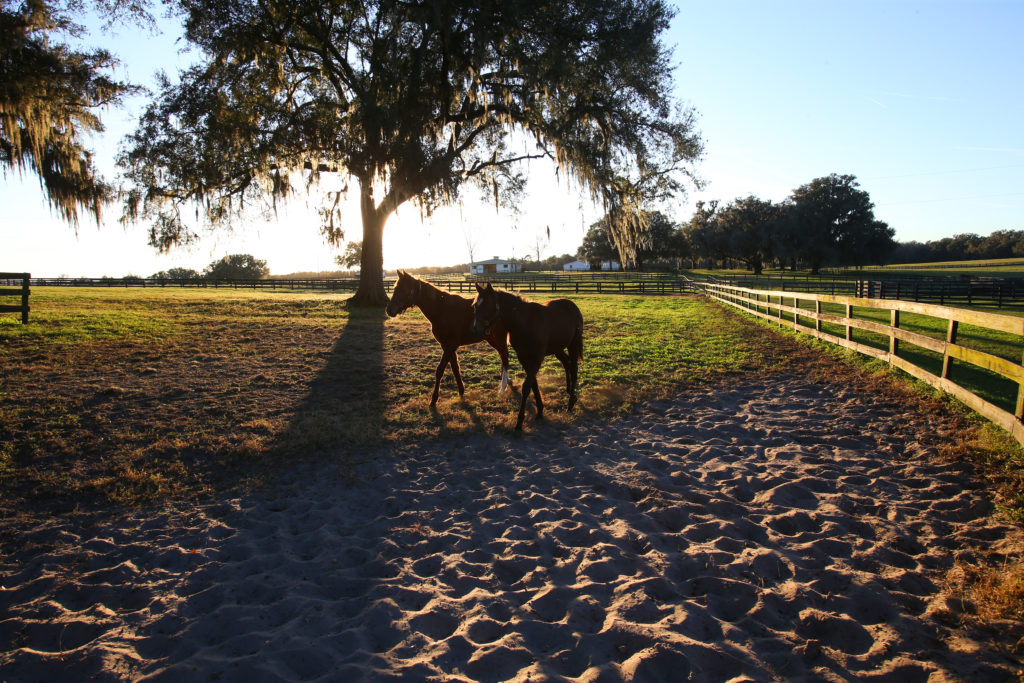 “From day one, I told both David and Joe that there would be no free rides for them at Ocala Stud,” says Mike, who has served multiple terms on the FTBOA and OBS boards of directors. “Just because their last name was O’Farrell didn’t mean they weren’t going to have to work. But they didn’t shy away from that and gradually became very involved in every aspect of the farm.”
“From day one, I told both David and Joe that there would be no free rides for them at Ocala Stud,” says Mike, who has served multiple terms on the FTBOA and OBS boards of directors. “Just because their last name was O’Farrell didn’t mean they weren’t going to have to work. But they didn’t shy away from that and gradually became very involved in every aspect of the farm.”
There was definitely a learning curve for Joe in transitioning from the banking business to the thoroughbred business.
“When I started at the farm, I really had no idea how many moving parts there are in an operation like Ocala Stud,” admits Joe, who has followed his father as a director on the FTBOA board. “We have about 60 to 70 employees during peak breeding, training and sales seasons. There’s about 90 broodmares between ours and clients. There are 50 to 60 foals born on the farm every year. We consistently have 150 sales and training horses. It’s a big operation.”
David took a more hands-on approach, working his way through the broodmare, stallion, training and sales division on his way to becoming assistant farm manager in 2014.
“I love being involved in all aspects of the farm,” says David. “Working with and learning from all the great longtime employees of the farm has been an ongoing education. And I’m very fortunate to be able to work with my family. I’ve grown to appreciate what my grandfather and my father managed to accomplish in a very tough business.”
Joe, who is the president of the Marion County Farm Bureau and treasurer of the Florida Horse Park, adds, “I have no regrets about making a career change when I did. I love getting to work with my family. And I enjoy being involved in the Florida thoroughbred industry, being an advocate for it to the wider Ocala community.”
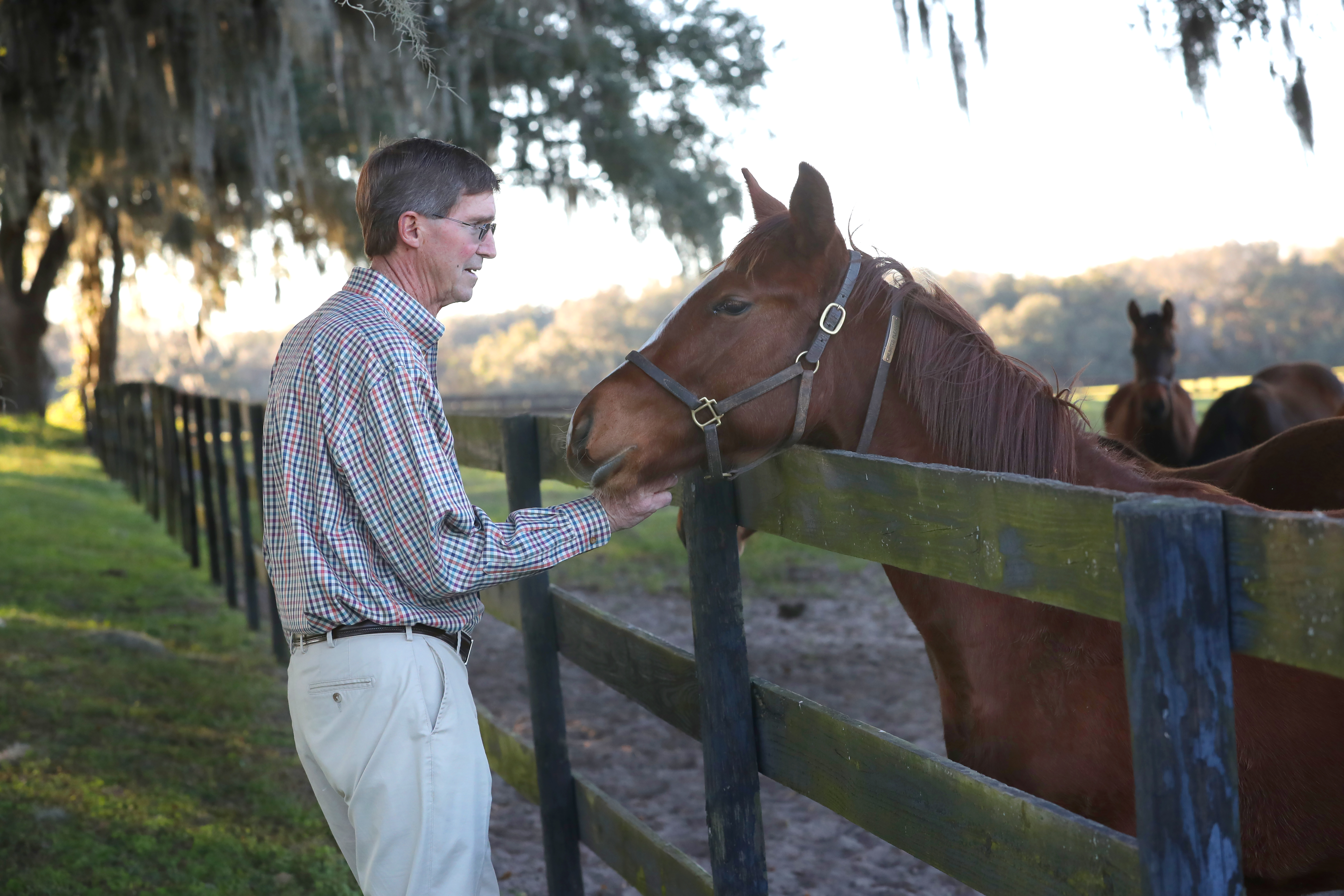 Joe and wife Alicia have an 11-year-old son, aptly named Joseph Michael O’Farrell IV. The latter goes by Michael and, Joe notes, “While he likes watching horse racing and rooting for Ocala Stud horses, right now his favorite things are baseball and fishing.”
Joe and wife Alicia have an 11-year-old son, aptly named Joseph Michael O’Farrell IV. The latter goes by Michael and, Joe notes, “While he likes watching horse racing and rooting for Ocala Stud horses, right now his favorite things are baseball and fishing.”
David and wife Allison, who have a home at the Ocala Stud Annex, have three children: Maggie (11), Annie (9) and John David Jr. (7).
“Maggie really likes getting up early on Saturdays and coming with me to the farm,” says David. “Both Maggie and Annie have horses and are taking riding lessons. Right now, John David is more into sports, but he likes coming to the farm too.”
Adapting to Change
For Mike, who still arrives at the farm at 6:30am six days a week, Joe and David becoming involved in Ocala Stud’s operation has been a success.
“Just like when I stepped in to work with my father, Joe and David brought a new energy into our operation,” says Mike. “They both have worked and continue to work very hard to keep Ocala Stud moving forward. I am very proud of them and the team we have become.”
Indeed, most mornings the O’Farrell team can be found at the racetrack, only a short walk from the office, watching the horses train. And, Mike says, “It’s always gratifying to watch our foals grow up and develop into racehorses. Spending mornings watching horses train never gets old.”
 The O’Farrells have also watched the relentless business and residential development close in around the farm, prompting a new chapter to Ocala Stud’s history. In 2011, the O’Farrell family sold the 185-acre original main site of the farm for $9 million to developer and thoroughbred horseman John Brunetti. The latter, who died in 2018, founded nearby Red Oak Farm, which is now operated by his son Steve Brunetti. Ocala Stud continues to operate on the property under a lease agreement.
The O’Farrells have also watched the relentless business and residential development close in around the farm, prompting a new chapter to Ocala Stud’s history. In 2011, the O’Farrell family sold the 185-acre original main site of the farm for $9 million to developer and thoroughbred horseman John Brunetti. The latter, who died in 2018, founded nearby Red Oak Farm, which is now operated by his son Steve Brunetti. Ocala Stud continues to operate on the property under a lease agreement.
“It was a financial decision made by the family to sell the property. But we didn’t sell the Ocala Stud name,” says Mike. “When the time comes that renewing our lease is not an option, we’ll just move the operation to our other properties. The plan is to continue to operate as we have for 64 years and counting—as a family operation.”
And that is sure to include the Ocala Stud sign.
For more information, visit www.ocalastud.com






